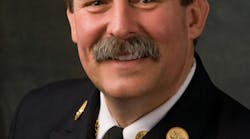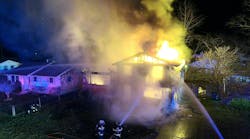Stephen McHenry took the Jacksonville firefighters on a tour Thursday of an electric, driverless shuttle as another NAVYA Autonom Shuttle slowly circulated nearby.
This kind of autonomous electric minibus is the future of mass transit, the first phase set to run between JTA's new headquarters near the Prime Osborn Convention Center and TIAA Bank Field in the next few years. It would then ultimately expand to a 10-mile circuit atop modified Skyway Express tracks into downtown and San Marco.
So McHenry, who works for the company that makes the Autonom Shuttle now being tested by JTA for its Ultimate Urban Circulator, pointed to what firefighters should do if the driverless vehicle gets in a crash.
"Right here is the safety disconnect for the battery, a quarter turn counter-clockwise. It kills the high-voltage battery to everything," McHenry said. "This goes to the charge cable. This goes to the systems in the front."
The JTA, NAVYA and autonomous mobility solutions company Beep conducted the day-long training session for firefighters, state troopers and sheriff's officers to learn about autonomous technology and how they will address emergency situations. That could be a crash on East Bay Street or an emergency 50 feet above on the Skyway Express that necessitates a firefighter shutting off power or a police officer steering the shuttle out of the way.
"We need to know the ins and outs of the vehicle," Jacksonville Fire and Rescue Battalion Chief Sean Hatchett said. "With them being battery-operated, batteries have problems we encounter from time to time. The battery may be on fire and we need ways to extinguish that properly and rescue people and maybe even disconnect power from the battery."
Learning about these vehicles in advance, even though they are years away, is better than learning "on the fly in a crisis" when one has a crash, Sheriff's Office Director Mike Bruno said.
"Our officers are here to get exposure to what the future looks like in Jacksonville," Bruno said.
The JTA's Ultimate Urban Circulator (U2C) began with discussion a few years ago about what to do with the 30-year-old Skyway Express, CEO Nathaniel Ford Sr. said.
"Those communities that prepare themselves for this new technology will be the communities that can leverage it for economic development, helping our customers travel more efficiently, and most importantly, they need to do it safely," Ford said. "... Today we want to start the beginnings of the training we need to conduct so you as first responders clearly understand this technology."
When a final manufacturer is chosen, 15 shuttles will navigate the first phase on the Bay Street Innovation Corridor, a 3-mile loop from Hogan Street in downtown to the stadium complex. Bay Street will be outfitted with smart sensors, traffic signals and digital traffic solutions to increase mobility, interact with the autonomous shuttles and help pedestrians, JTA said.
The automated fleet would ultimately run on overhead Skyway tracks north to the JTA's Rosa Parks transit hub on West State Street to access buses. They would also cross the Acosta Bridge's Skyway track into San Marco and Kings Avenue parking garage. U2C shuttles would use ramps from the Skyway to run on city streets.
"We use that existing infrastructure and convert the Skyway as well as build an at-grade portion connecting all that to connect the various neighborhoods through the downtown corridor," said JTA VP of Automation Bernard Schmidt.
The JTA began testing possible shuttle manufacturers in 2017 on a temporary site near TIAA Bank Field, offering regular public rides. NAVYA is the third company selected for test runs, and a fourth company is testing soon, JTA said.
The 15-foot-long NAVYA Autonom Shuttle uses LIDAR (laser sensors), plus cameras scan for people, cars, bicyclists and other obstructions as it "reads" traffic signals and lanes. That's all tied into computers that will let it drive up to 25 mph autonomously, although a "safety operator" will be on board initially, officials said. And if police and firefighters need to actually drive the NAVYA Shuttle from an accident scene, they learned that an xBox controller hidden inside can handle that.
To see what first responders learned Thursday, check out the city's video of the program at https://bit.ly/2N69XfG. For more information on JTA's U2C program, go to u2c.jtafla.com. And for more information on the current AVYA shuttle, go to navya.tech/en/autonom-shuttle.
———
©2019 The Florida Times-Union (Jacksonville, Fla.)
Visit The Florida Times-Union (Jacksonville, Fla.) at www.jacksonville.com
Distributed by Tribune Content Agency, LLC.






